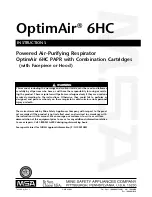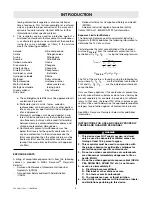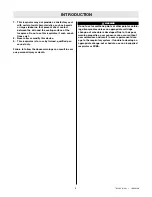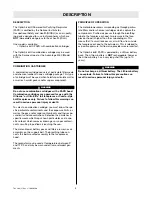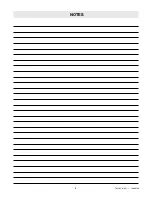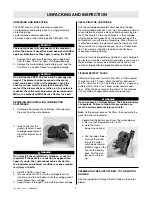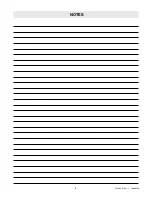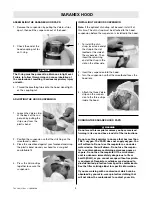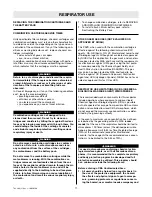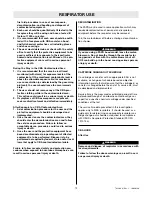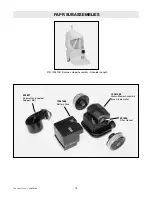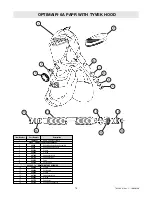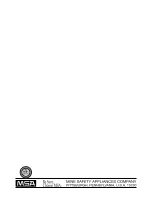
INTRODUCTION
lowing contaminants regardless of concentration or
time of exposure. This far-from-complete list is offered
only as a guide to proper evaluation of the many cont-
aminants found in industry. Contact MSA for further
information on other specific material.
5. This respirator can be used for protection against a
mixture of contaminants that are present simultaneous-
ly or alternately against one contaminant then another
(using the same cartridges or filters) if the mixture
meets the following conditions:
a. The cartridge/canister/filter must be approved for all
contaminants present.
b. Particulates (dusts, mists, fumes, asbestos,
radionuclides) can be mixed with any other particu-
late or any gas or vapor for which the cartridge/can-
ister is approved.
c. Mersorb-H cartridges may be used against a mix-
ture of chlorine and mercury that are both present
simultaneously, but may not be used if alternating
between mercury-contaminated atmospheres and
chlorine-contaminated atmospheres.
d. Contaminants present simultaneously must be
below IDLH levels for the specific contaminants. If
any one contaminant in the mixture exceeds the
IDLH concentration then the entire mixture must be
treated as IDLH and the respirator cannot be used
(except for escape from particulates with appropri-
ate filter).
EXPOSURE LIMITS
A listing of acceptable exposure limits from the following
sources is provided in MSA’s
Response® Respirator
Selector
:
-
American Conference of Governmental Industrial
Hygienists (ACGIH)
-
Occupational Safety and Health Administration
(OSHA)
-
National Institute for Occupational Safety and Health
(NIOSH)
-
American Industrial Hygiene Association (AIHA)
Contact MSA at 1-800-MSA-2222 for information.
Exposure Limits for Mixtures
The American Conference of Governmental Industrial
Hygienists (ACGIH) publishes the following information to
determine the TLV of a mixture.
First determine the total concentration of the chemical
mixture (CMixture) from the individual contaminant con-
centrations (C1, C2, C3, . . . ) using the following formula:
CMixture=C1+C2+ C3+ . . .
The TLV of the mixture is found by using the following for-
mula where T1, T2, T3, . . . are the individual contaminant
TLVs and C1, C2, C3, . . . are the individual contaminant
concentrations:
Only use these equations if the contaminants present are
actually mixed. Some substances do not mix and may be
present separately, for example, in pockets or at different
levels. In that case, the lowest TLV of the substances pre-
sent must be used to determine the appropriate respirator
category for protection against all contaminants present.
See MSA’s
Response Respirator Selector
for additional
information.
INSTRUCTIONS FOR USE AND CARE BY PROPERLY
TRAINED AND QUALIFIED PERSONNEL
1. This device does NOT supply oxygen, and must
only be used in adequately ventilated areas con-
taining at least 19.5 percent oxygen.
2. This respirator must be used in conjunction with
the proper chemical or particulate cartridges for
protection against specific contaminants.
3. Do not use when concentrations of contaminants
are unknown or immediately dangerous to life or
health (IDLH).
4. Do not use when appropriate exposure limit (OSHA
PEL, NIOSH REL, ACGIH TLV, etc.) is not known.
5. Leave area immediately if:
A. Breathing becomes difficult.
B. Dizziness or other distress occurs.
C. You taste or smell contaminant.
D. You experience nose or throat irritation.
6. Use strictly in accordance with instructions, labels,
and limitations pertaining to this device.
3
TAL 209 (L) Rev. 1 - 10040590
WARNING
Acrolein
Aniline
Arsine
Bromine
Carbon monoxide
Diisocyanates
Dimethylaniline
Dimethyl sulfate
Hydrogen cyanide
Hydrogen selenide
Methanol
Methyl bromide
Methyl chloride
Methylene chloride
Nickel carbonyl
Nitric Acid
Nitro compounds:
Nitrogen oxides
Nitroglycerin
Nitromethane
Ozone
Phosgene
Phosphine
Phosphorous
trichloride
Stibine
Sulfur chloride
Urethane or other
diisocyanate-con-
taining paints
Vinyl chloride
T
Mixture
=
C
Mixture
+
+
+ . . .
T
1
T
2
T
3
C
1
C
2
C
3
Summary of Contents for OptimAir 6HC
Page 6: ...NOTES 6 TAL 209 L Rev 1 10040590 ...
Page 8: ...NOTES 8 TAL 209 L Rev 1 10040590 ...
Page 15: ...15 TAL 209 L Rev 1 10040590 20 ...
Page 16: ......

